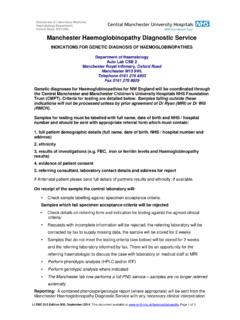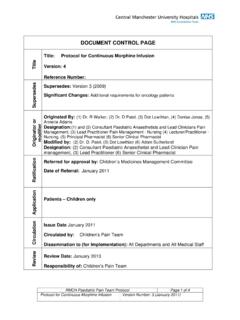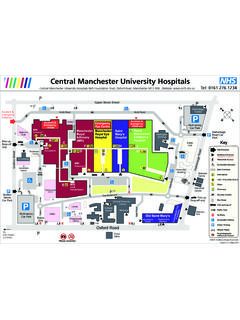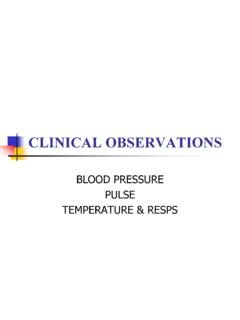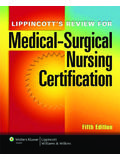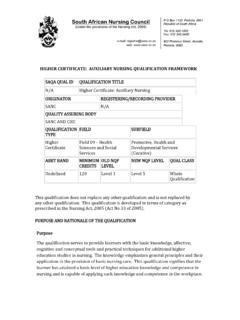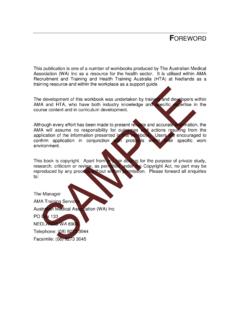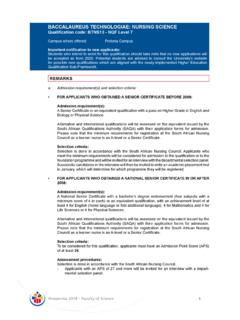Transcription of nursing activity. However it requires knowledge of
1 An introduction to the principles and practice of safe and effective administration of injectionsGiving an injection safely is considered to be a routine nursing activity. However it requires knowledge of anatomy and physiology, pharmacology , psychology, communication skills and practical expertise. Today we will emphasise the research based practices that are known to encourage nurses to incorporate best practice into an everyday procedure. Introduction Recognise the five reasons why medication may be given by injection (parenteral route) Intended Learning Outcomes Differentiate between the structures involved and uses of the intramuscular (IM) and subcuctaneous (SC)
2 Outline factors influencing choice of syringes and needles Outline sites, basic preparation and administration techniques for the IM and SC routes Recognise the importance of universal precautions when giving injections Equipment Route Site Technique Safety Considerations For secure connections Eccentric Luer slip Concentric Luer slip Luer Lok Allows one to get closer to the skin For all other applications EquipmentWhat needle should I use for IM injections? 21G or 23G Green or blue hub Length depends on patient and site Equipment 25g or 26g Orange or brown hub Length depends on patient and site What needle should I use for SC injections?
3 EquipmentBlunt Filter/ Fill Needles Filter out subvisible particles of glass, rubber, fibre and other residues. The infusion of these particles has been linked with phlebitis,vascular occlusion and subsequent embolism,formation of granulomas and septicaemia. They are for use when withdrawing drugs from vials and glass ampoules. Particle Contamination EquipmentBlunt Fill Blunt Filter Equipment Rapid action required Drug altered by intestinal secretions Drug not absorbed by alimentary tract Patient cannot take oral drug Drug unavailable in oral form Reasons for Giving Medication by Injection InjectionsPreparation of Patient Promote comfort and relaxation Explain reason for injection Describe the procedure /obtain informed consent Check for any allergies/history of anaphylaxis Check prescription/drug/patient identify Check expiry dates and record lot numbers Avoid over exposure of patient Positioning
4 Of patient Select site Select correct needle length and syringe Wash hands and apply gloves Prepare injections using aseptic technique Procedure for Injections Injections Check patient identity Skin preparation (local policy) Inject slowly and remove needle Document procedure Review the individual as appropriate Procedure for Injections InjectionsPreparation of skin prior to Injections Little evidence to support the need for disinfection of the skin prior to subcutaneous or intramuscular injection If soiled, However , skin should be cleaned by soap and water or can be disinfected by an alcohol swab (if alcohol swab has been used allow the alcohol to evaporate before injecting) Refer to local policy InjectionsHow many sites can be used to give an injection?
5 1) The Deltoid. 2) The Ventrogluteal site. 3) The Dorsogluteal 4) The Vastus Lateralis. Intramuscular Route InjectionsVastus Lateralis Deltoid Dorsogluteal Ventrogluteal Sites for IM Injections InjectionsTraditionally nurses were told to divide the buttocks into four quadrants INJECT INTO THE UPPER OUTER QUADRANT Injections Clinical study Cockshott,et Med,307 (1982) dorsogluteal injections in 213 adults 1 inch (or 38 mm) 21g green needle localisation using CT scans Conclusions Only 5% of women Only 15% of men actually received IM injections, all other injections went into subcutaneous tissue Intramuscular Injection Variability in subcutaneous tissue thickness InjectionsMRI close up scan of the buttocks The distance from skin to muscle in this patient (line marked 1) is 42mm An injection given with a 38mm (11/2 )
6 Needle stayed in the fatty SC tissue Intramuscular Injections Injections The Double Cross Divide the buttock with an imaginary cross THEN divide the upper outer quadrant by another imaginary cross Inject into the upper outer quadrant of the upper outer quadrant A Recent Adaptation of this Approach InjectionsInjections The Double Cross The Double Cross InjectionsThe Double Cross InjectionsVastus Lateralis Bunch up in elderly, emaciated or infants Divide thigh into thirds, inject into bottom of top 1/3 Intramuscular Injections InjectionsDeltoid Identify the Greater Tuberosity Move 5cms (1 2 inches) below the site Rotate arm to confirm site Intramuscular Injections InjectionsZ tracking Procedure Pull skin taut then Insert needle Remove needle and release skin Intramuscular Injections InjectionsZ tracking Procedure Pull skin taut Keeping skin taut with heel of hand insert needle at a 90% angle Aspirate plunger over 5 10 seconds noting any blood If clear inject 1ml every 10 seconds Wait 10 seconds before removing needle (Beyea & Nicoll 1995)
7 Keep skin taut until needle removed Don t massage the site Check patient and site (30 minutes) Intramuscular Injections InjectionsZ tracking Procedure Pull skin taut then Insert needle Remove needle and release skin Intramuscular Injections InjectionsRecommended medication volumes per muscle site Ventrogluteal Up to 4ml in a well developed muscle Up to 2ml in less developed muscle Vastus lateralis Up to 4ml in a well developed muscle Up to 2ml in less developed muscle Deltoid Up to 1ml in a well developed muscle Up to in less developed muscle InjectionsSubcutaneous Route InjectionsSpeed of Absorption in Injection Sites Injections Lift skin fold Puncture skin at 90 degrees Do not aspirate
8 Inject slowly and remove needle Release lifted skin fold Procedure for Subcutaneous Injections InjectionsAbdomen Thigh Scan: Thin Patient Injections performed with an 8mm needle, Without a lifted skin fold (left) With a lifted skin fold (right) InjectionsNo lifted skin fold Lifted skin fold InjectionsCorrectly lifted skin fold Incorrectly Lifted skin fold InjectionsPotential Complications Infection Incorrect location of injectate Pain Anaphylaxis InjectionsPotential Complications Long and short term nerve damage Intramuscular haemorrhage Hitting a blood vessel Sterile abscess Lipodystrophy InjectionsUnderstand the legal & professional responsibilities when administering an injection.
9 Legal and Professional Training and direct supervision with mentor Carry out procedure in accordance with Trust policy Develop competence Practice your skill regularly Do not proceed unless confident Documentation Legal and ProfessionalWho gets injured? 35% are nursing Staff Where does the injury occur? 37% in the patients room/ward Was the sharp contaminated? 78% Yes 36% NSI occur during use 19% NSI occur during an injection (intramuscular/subcutaneous) EPINet TM data for Needles and Syringes 2003 Safety IssuesIf I am stuck with an infected needle what is the risk? HBV 1 in 3 HCV 1 in 30 HIV 1 in 300 SafetyCost to practitioner Immeasurable stress Lifestyle changes Possible premature death Cost to employer Covering sickness Treatment costs Litigation Recruitment and retention of staff SafetyThe National Audit Office (NAO 2003) The report stated needlestick and sharps injuries accounted for 17% of accidents to NHS staff and were the second most common cause of injury, behind moving and handling at 18%.
10 At least four UK HCW s are known to have died following occupationally acquired HIV infection Since 1996, the HPA has received reports of nine HCW s who have been infected with HCV because of occupational exposure With 40,000 reported incidents a year and at least as many unreported, needlesticks and sharps injuries are a significant issue. The management of health, safety and welfare issues for NHS staff New edition 2005 SafetyStandard Precautions Skin Cuts or abrasions in any area of exposed skin should be covered. Gloves Well fitting clean gloves must be worn during procedures where there may be contamination of hands by blood/body fluids.

